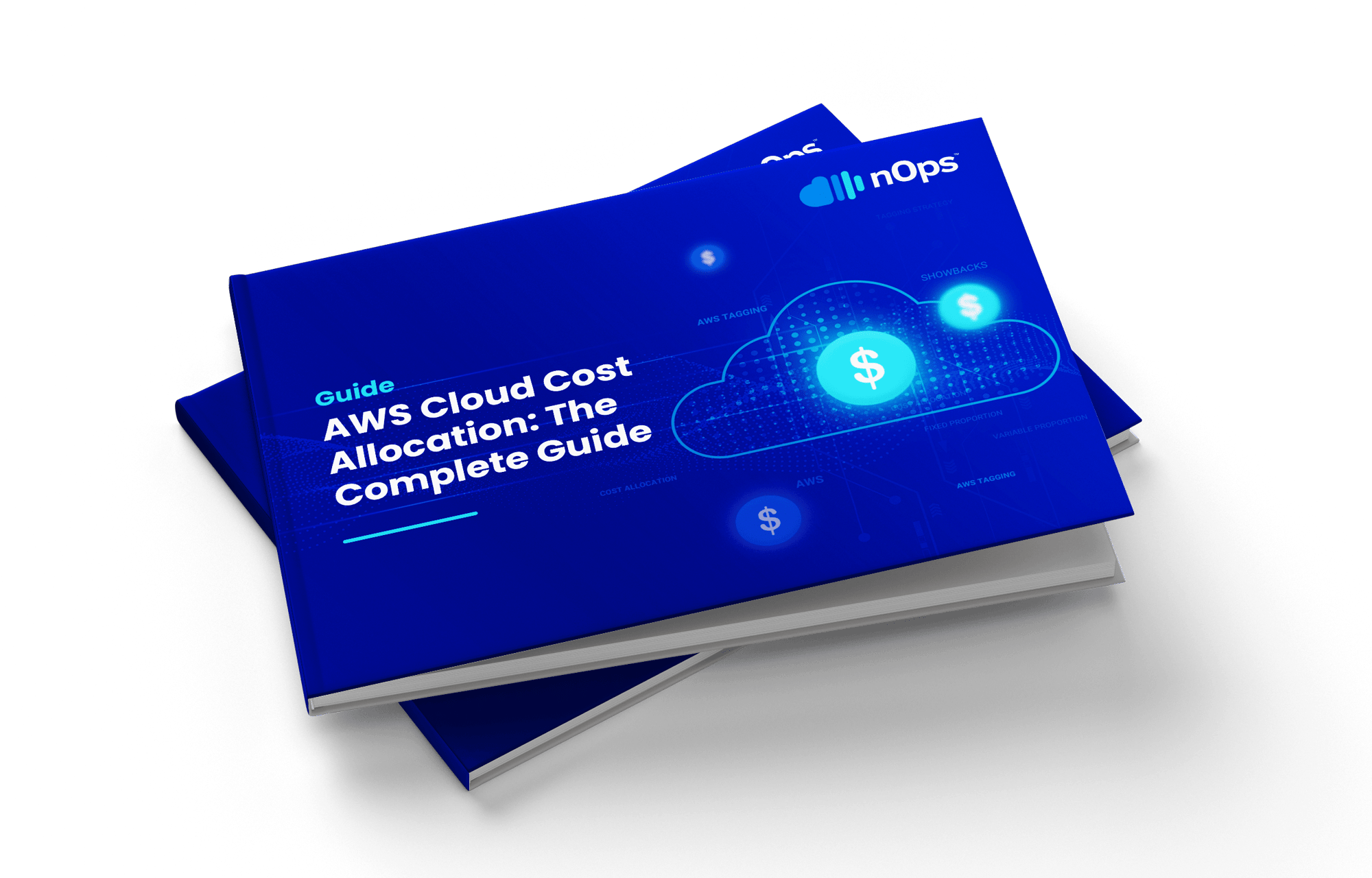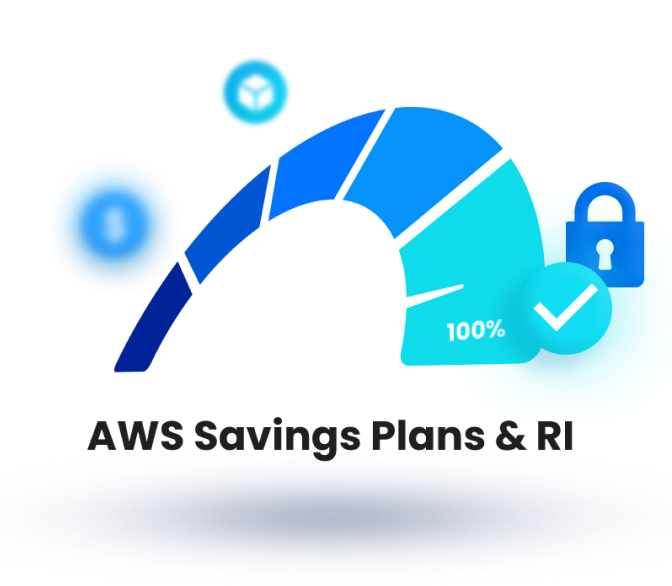Savings Plans are AWS discounts that allow you to save money by comitting to a specific amount of usage over a time period. However, forecasting spending commitments is an art. In the dynamic world of cloud infrastructure, systems are constantly evolving — your team is constantly modernizing and rightsizing, so the overall cloud usage fluctuates.
Any time you buy Saving Plans, you are committed to the usage for every hour. Because you pay for the commitment regardless of usage, for every hour you don’t hit that usage level, you lose money. This is known as “unused commit.” And if you approach it too carefully and end up under-committing, you’ll wind up paying for the resources your team needs at the highest AWS price tier.
In this blog post, we’ll go over the different types of Saving Plans, and how to optimize them; we’ll also go over the nOps risk-free Savings Plan solution, where nOps guarantees against any underutilization. Let’s start by going over different types of saving plans.
What Are AWS Savings Plans?
AWS Savings Plans are a flexible pricing model offering lower prices than On Demand pricing in exchange for a specific usage commitment (measured in $/hour) for a one- or three-year period.
Unlike Reserved Instances (a similar AWS discount model), which require you to commit to specific instance types and configurations, Savings Plans offer the same discounted rates with more flexibility across instance families, regions, and services.
AWS Saving Plan Types
AWS offers three types of Savings Plans:
- Compute Savings Plans
- EC2 Instance Savings Plans
- Amazon SageMaker Savings Plans
Let’s compare the features, pros and cons of each type.
Compute Savings Plans
Compute Savings Plans are the most flexible option. They apply to usage across Amazon EC2, (regardless of instance family, size, AZ, region, OS, or tenancy), AWS Lambda, and AWS Fargate.
For example, you could change a c4.large instance in Ireland to an t4g.16xl instance in London and still receive the AWS Savings Plan discount.
Compute Savings Plans offer discounts up to 66%. Their flexibility and ease of use make them a good fit for modern, dynamic architectures.

EC2 Instance Savings Plans
EC2 Savings Plans provides the lowest Savings Plan prices, with savings up to 72% (compared to 66% for Compute SP) to help you reduce your monthly On Demand spend.
However, they are more restrictive: you need to commit to a specified region and instance family, though you can change instance size, OS, and tenancy.
Savings only apply to EC2 usage — not to services like Fargate or Lambda. These plans are best suited for stable workloads where the instance family and region are unlikely to change.
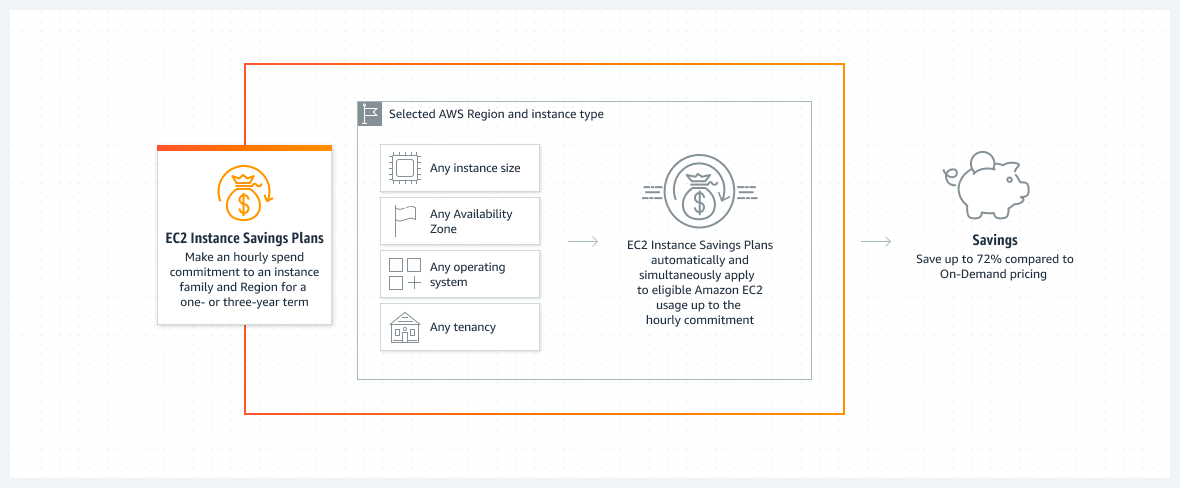
Amazon SageMaker Savings Plans
SageMaker SP will apply to any ML instance or size, across any region, without manual modifications required.
If you have a consistent amount of Amazon SageMaker eligible usage (measured in $/hour), and use multiple SageMaker components or expect your technology configuration (e.g. instance family, region) to change over time, SageMaker Savings Plans make it simpler to maximize your savings while providing flexibility to change underlying technology configuration based on application needs or new innovation.
SageMaker Savings Plans offer up to 64% in savings compared to On-Demand pricing. While not as broad as Compute SPs, they provide more flexibility than Reserved Instances for ML workloads.
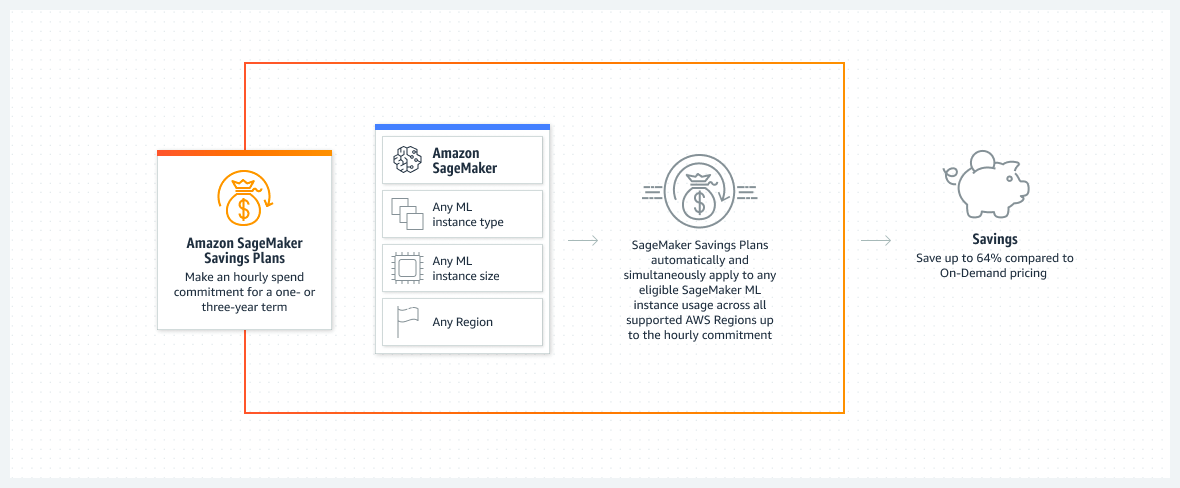
How Much Do AWS Savings Plans Cost?
The cost of a Savings Plan is based on your committed usage, measured in $/hour, over a 1- or 3-year term. The actual rate you pay depends on the Savings Plan type, the services and configurations you use, and the payment option you select.
AWS offers three payment options:
- All Up-front: Pay the full amount at the start of the term. This provides the maximum discount but requires the highest commitment.
- Partial Up-front: Pay a portion up-front and the rest monthly. This balances risk and savings.
- No Up-front: Pay monthly with no initial payment. While it offers the lowest commitment flexibility, it also comes with slightly smaller discounts.
You’re not paying for a specific instance—you’re committing to a spend rate, and AWS automatically applies the best available discount to your eligible usage.
The Ultimate Guide to AWS Commitments
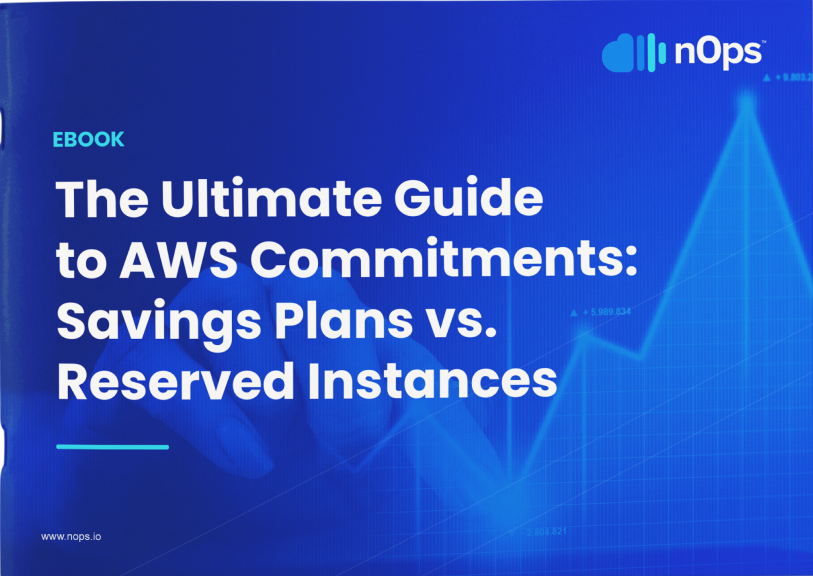
Benefits of Using AWS Savings Plans
- Compute Savings Plans can apply to any instance, maximizing the value and flexibility of the plan you purchase.
- Savings Plans offer the flexibility to make infrastructure modifications while still receiving discounts.
- A Savings Plan automatically applies to eligible compute usage, regardless of changes to your infrastructure.
- You purchase Savings Plans on a dollar-per-hour basis, not per instance. As a result, SP allows you to purchase compute capacity for as little as a fraction of a cent per hour – one tenth of a cent per hour, to be exact ($0.001/hr).
- SPs offer multiple purchase plans, meaning you have the flexibility to pay upfront or monthly. And, you can schedule them to apply automatically at a later date (called “queuing”).
How is an AWS Savings Plan applied?
Savings Plans apply to your usage after any Amazon EC2 Reserved Instances (RI) you have are applied, because they are broader. Following the same principle, EC2 Savings Plans are applied before Compute.
Savings Plans are applied first to the usage of the purchaser’s account, then to other accounts in the Consolidated Billing Family. This is known as account affinity and is important to keep in mind.
Savings Plans prioritize covering usage with the highest discount rate(s) first, after purchasing affinity. They will be applied until all usages are accounted for, or until your commitment is met. Any remaining usage will be charged at On-Demand rates. Savings Plans will apply their discount at a lower discount for usage within the purchasing account before it will “float” to another account to cover usage. This is why it’s a best practice to either buy Savings Plans from the Root account, or an empty account specific for this purpose.
How to buy AWS Savings Plans
You can access Savings Plans in the AWS Billing and Cost Management console, or directly by opening the AWS Cost Management console. You can add your selection to your Savings Plans cart from the Recommendations page or from the Purchase Savings Plan page. You can also manage Savings Plans later in the AWS Cost Management Console.
Any existing Savings Plans that has an hourly commitment of $100 or less, purchased in the past 7 days and in the same calendar month can be returned.
Expected Savings with AWS Savings Plans
Here is a quick comparison of different commitment options to consider. For more information, see Savings Plans vs Reserved Instances: The Ultimate Guide.
| EC2 Instances Savings Plans | Compute Savings Plans | Standard Reserved Instances |
Commitment term | 1 year, 3 years | 1 year, 3 years | 1 year, 3 years |
Best case-scenario savings | 72% | 66% | 72% |
Payment Options | All Upfront, Partial Upfront, and No Upfront payment | All Upfront, Partial Upfront, and No Upfront payment | All Upfront, Partial Upfront, and No Upfront payment |
Instance Family | Any | Fixed | Fixed |
Instance Size | Any | Any | Fixed except regional scopes that use Linux/Unix |
Instance Operating Systems | Any Operating System | Any Operating System | Fixed |
Instance AZ | Any | Any | Any (regional scope) Fixed (zonal scope) |
Instance Tenancy | Any | Any | Fixed |
Applicable to | EC2 only | EC2, Lambda, and Fargate | EC2 only |
Need to reserve capacity? | No | No | Yes (Zonal scope) |
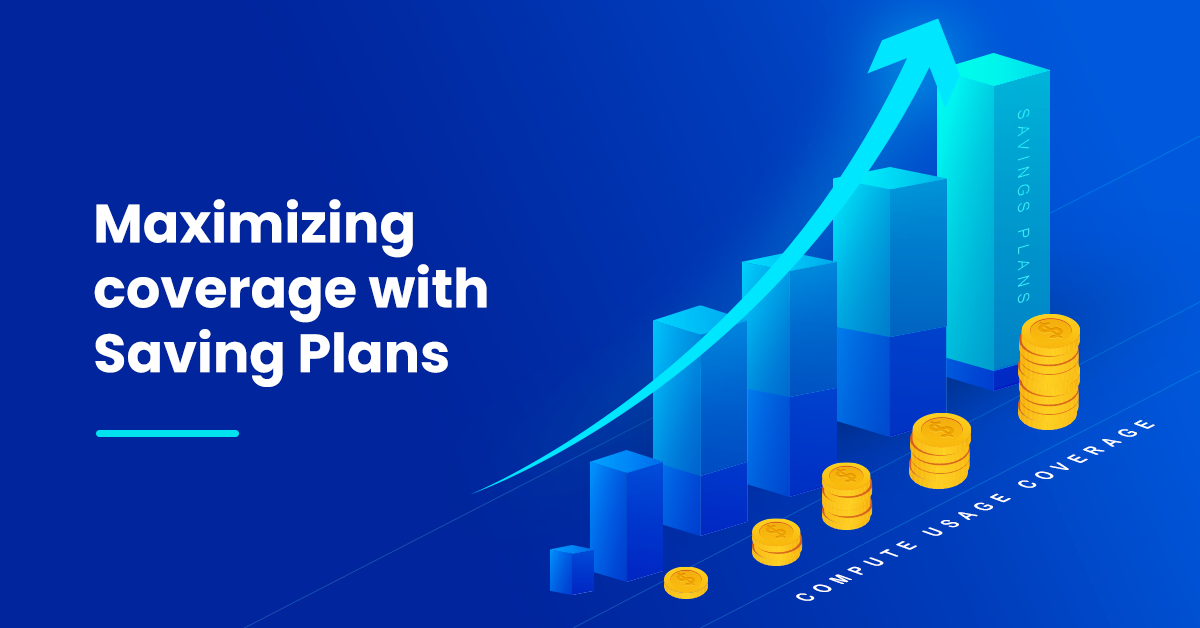
How to Maximize Coverage with AWS Savings Plans?
Here are some principles you need to keep in mind when determining how to optimize your Savings Plan usage.
1. Isolate the services to be covered by Savings Plans
Savings Plans don’t cover everything — they cover EC2, Fargate, and Lambda. They do not cover non-compute elements such as EBS volumes or data transfer. Many companies look at total EC2 spend when determining the commit level, leading to a lot of unused commit over the term.
When considering how much SP to purchase, you’ll also need to consider your existing commitments. Discounts do not stack — for example, if you’ve already purchased RIs, Savings Plans will apply only to compute not covered by these commitments.
And because discounts don’t stack, Spot is also not eligible for discounting with a Savings Plan.
2. Analyze your On-Demand Compute Costs on an hourly basis
Savings plans apply on an hourly basis, meaning that you’ll need to get fairly granular in your breakdown. Consider using AWS Cost and Usage Reports (free), AWS Cost Explorer (paid), or a free third-party tool such as nOps Business Contexts to track the relevant data and determine estimated monthly savings.
To make things easier, we advise viewing your cloud costs in amortized view. Amortizing is when you distribute one-time reservation costs across the billing period that is affected by that cost. Amortizing enables you to see your costs in accrual-based accounting as opposed to cash-based accounting. For example, if you pay $365 for an All Upfront RI for one year and you have a matching instance that uses that RI, that instance costs you $1 a day, amortized.
3. Recognize that an AWS Savings Plan doesn’t normally cover spikes.
The plans are ideal for a steady and predictable compute spend level. You’ll commit to using the agreed capacity per hour. If you exceed this usage, AWS will use On-Demand billing for extra charges.
Let’s look at an example of a typical usage pattern for illustration.
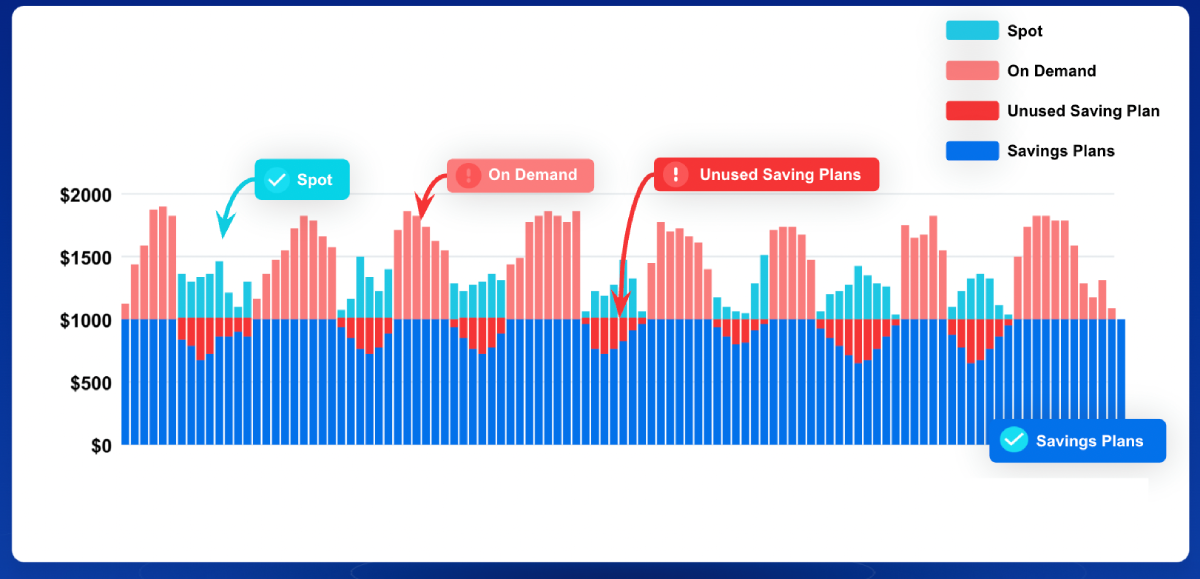
As you can see, spikes aren’t normally covered by Saving plans. However, the spiky nature of these workloads makes Spot a great option. Once you cover these spikes with Spot, you are essentially “pushing up” your Savings Plan coverage and getting the maximum discount on your usage.
However, you need to ensure you’re moving the right amount of your workload onto Spot. Moving too much usage onto Spot may mean you’re left with unused commitments — meaning wasteful spending. Monitoring usage closely and continually to find the right balance can be difficult.
4. Savings Plans are retroactively applied
One of the technical complexities of AWS cost optimization is that an AWS Savings Plan is retroactively applied 12 hours after the usage already occurs.
To make the best decisions balancing RI, SP and Spot to achieve truly optimal savings, it’s necessary to be aware of all of your usage and commitments across your entire AWS ecosystem at all times.
The challenge is that truly optimizing the placement of your AWS workloads to maximize savings can be complex and time-consuming — requiring dedicated resources and operational expenses to do correctly.
What are Freeable Savings Plans?
The “Freeable Savings Plan” is an advanced technique that allows you to achieve next-level commitment management savings.
As explained, AWS automatically applies Savings Plans to (1) the account where the RI was purchased first and (2) by the order of highest discount.
In many cases, it would be better to move a workload onto Spot and apply some of the Savings Plan not to the highest discounted usage, but to other, harder-to-cover resources. By “freeing up” Savings Plans to cover these resources, you get a discount on all of your compute for greater overall savings.
And because Savings Plans can apply across your organization, resources even outside of your workload can be covered by freed savings plans.
How nOps Helps You Select the Best AWS Savings Plans?
nOps fully automates the commitment management process. It takes the complexity of juggling RI, SP, and/or Spot off your hands to maximize cost savings with zero engineering effort.
It continually monitors Spot market pricing, your dynamic usage, and your existing commitments, to move workloads covered by Savings Plan commitments to Spot when doing so will result in overall cost savings. Simultaneously, it ensures Reserved Instances and Savings Plans don’t go underutilized.
nOps works across your entire AWS organization to eliminate underutilization, squeeze more out of your commitments, and make all your services organization- and Spot market-aware.
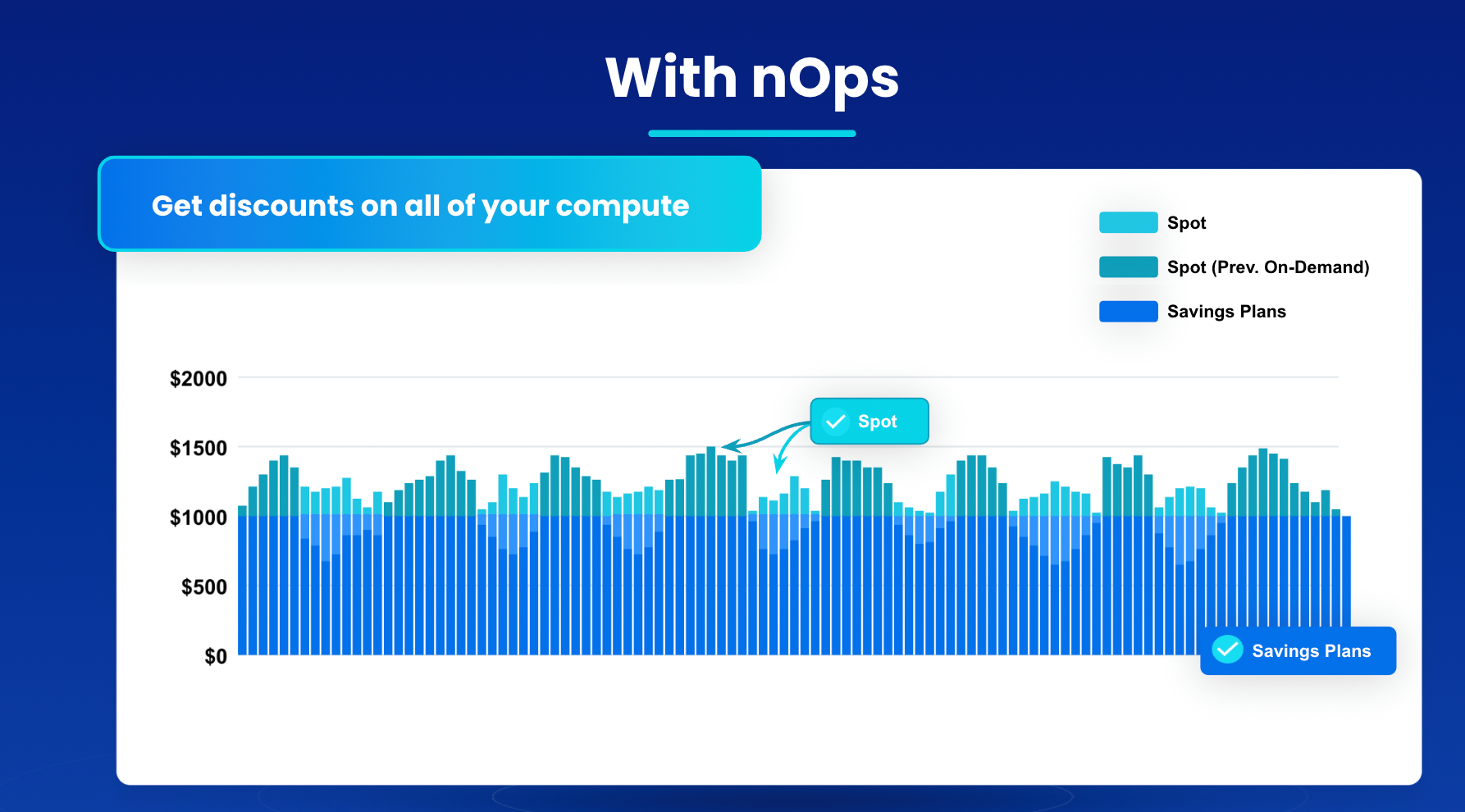
nOps is a complete package that delivers you significant cost savings, while freeing up your time from resource management so you can focus on innovation. With nOps, you get:
100% Utilization guarantee. nOps guarantees that you’ll use 100% of your Savings Plans. Or, we’ll fully refund any unused commitments to you for the commitments we manage.
Cost-optimized compute management. Our AI has real-time awareness of the Spot market, your existing commitments, and your changing usage. It automatically schedules the optimal instance types for your workloads, balancing between Compute SP and Spot to save you the most money.
On-demand reliability for Spot. nOps uses ML to predict Spot termination 60 minutes in advance. It selects diverse instances with minimal risk of interruption for the highest standards of reliability. As a result, you can effortlessly run many production and critical workloads on Spot with complete confidence.
No out-of-pocket cost. You pay only a percentage of your realized savings, making adoption risk-free.
The unique thing about nOps is that it lives on the true promise of the cloud. By optimizing all of your usage in real-time and backing you with a credit for any unused commitments we manage, you are freed from the risk of paying for more than you use.
nOps is entrusted with over 2 billion dollars of AWS spend, and the platform was recently ranked #1 in G2’s cloud cost management category. Join our customers saving up to 50% by booking a demo today!
Frequently Asked Questions (FAQ)
What is a Savings Plan in AWS?
AWS Savings Plans let you commit to a consistent hourly spend over 1 or 3 years in exchange for discounted rates. The discount applies automatically across services like EC2, Fargate, and Lambda, helping reduce compute costs while offering more flexibility than Reserved Instances. However, the challenge is often figuring out how much Savings Plans for compute usage to commit to – if you don’t buy enough you’ll be stuck paying costly On Demand rates, but if you buy too much, you’ll unnecessarily spend on unused SP.
What is the difference between Savings Plans and Reserved Instances?
Savings Plans apply to a broader set of compute options and adjust automatically across instance types, sizes, and regions. Reserved Instances are more rigid, requiring upfront decisions about instance type and region. However, Convertible Reserved Instances can be exchanged for other RIs with different attributes. Both offer discounts, but the type of flexibility they offer is different.
What are the two types of Savings Plans AWS offers?
The two types of Savings Plans offered by AWS are Compute and EC2 Savings Plans. Compute Savings Plans apply to any EC2 instance, Fargate, or Lambda usage across all regions and instance types. EC2 Instance Savings Plans offer higher discounts but are limited to a specific EC2 instance family and region, making them better suited for predictable, stable workloads.
Do Savings Plans cover Spot instances?
No, Savings Plans don’t apply to Spot Instances. Spot pricing is already deeply discounted, and usage doesn’t count toward your Savings Plan commitment. If you rely on Spot, treat it as separate from your committed spend when planning Savings Plan coverage. (This can be tricky to manually manage — consider a solution like nOps to automate the process for you).
